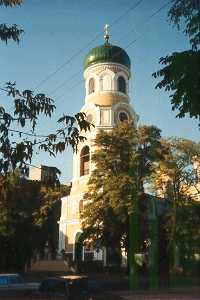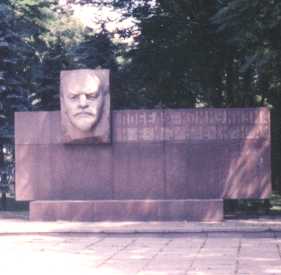Dnepropetrovsk |
The Church in Dnepr.
Dnepropetrovsk was opened to missionary work in late 1993. Missionaries experienced rapid and efficient success until the local government closed the city to proselyting in September, 1994. foreign missionaries were forbidden to engage in active missionary work in the city until the ban was lifted in April, 1997. Dnepropetrovsk now has 4 branches, all of which are presided over by local members. These four together with the 1 Zaporozhye branch make up the Dnepropetrovsk District. The district President is Brother Davidov of the Dnepr Center branch.
About the City.
Dnepropetrovsk, more commonly known amongst natives and missionaries alike as Dnepr, is situated in the central eastern region of Ukraine. The origins of this city of about 1.5 million people date from 1776 when Potyomkin was given instructions to construct a new city on the banks of the Dnepr River. Known as Yekaterinoslav, in remembrance of Catherine the Great, its name was changed to Dnepropetrovsk (the "D" is silent) on 26 June, 1926.
 Dneprs geographical
location has determined its fate, economically speaking. Located midway between the mines
of the Donbass and the industrial Krivye Rog region, it became one of the metallurgical
centers of the southern part of the Russian Empire. In Soviet times the city was
considered the industrial capital of Ukraine, with over 140 large, heavily industrial,
enterprises. Due to the importance of many of these enterprises to the Soviet
military, Dnepropetrovsk was closed to all foreigners while under Soviet rule. One of the
biggest of these military factories is the Yuzhmash Zavod (Southern Machine building
Factory) which once manufactured over half of the Soviet Union's ballistic missiles.
Since 1991 it has been converted to civilian use, including he destruction of Ukraine's
arsenal of nuclear missiles, which is monitored by U.S. inspectors.
Dneprs geographical
location has determined its fate, economically speaking. Located midway between the mines
of the Donbass and the industrial Krivye Rog region, it became one of the metallurgical
centers of the southern part of the Russian Empire. In Soviet times the city was
considered the industrial capital of Ukraine, with over 140 large, heavily industrial,
enterprises. Due to the importance of many of these enterprises to the Soviet
military, Dnepropetrovsk was closed to all foreigners while under Soviet rule. One of the
biggest of these military factories is the Yuzhmash Zavod (Southern Machine building
Factory) which once manufactured over half of the Soviet Union's ballistic missiles.
Since 1991 it has been converted to civilian use, including he destruction of Ukraine's
arsenal of nuclear missiles, which is monitored by U.S. inspectors.
~Chris Williams